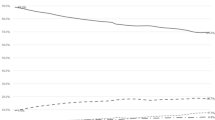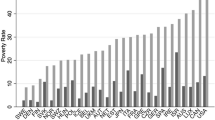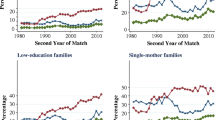Abstract
Since the implementation of the Temporary Assistance for Needy Families (TANF) program in late-1996, welfare rolls have declined by more than half. This paper explores whether improvements in the economic well-being of children have accompanied this dramatic reduction in welfare participation. Further, we examine the degree to which the success or failure of welfare reform has been shared equally among families of varying educational background. We analyze data from the March Current Population Surveys (CPS) over the years 1988 through 2001. Specifically, we link data for families with children who are interviewed in adjacent years and determine whether their economic circumstances either improved or deteriorated. We use two alternative approaches to address this general issue: a variety of regression models and a difference-in-differences methodology. These approaches provide consistent answers. In a bivariate framework TANF is associated with higher incomes; but this association becomes insignificant in the presence of business cycle controls. We also determine that children who were poor at an initial time period benefit differently, depending on their parents' educational attainment level. Poor children with parents who do not have a high school degree are significantly worse off in the TANF era, relative to the era prior to welfare reform, than are poor children of more educated parents.
Similar content being viewed by others
References
Allison, P.D. (2000). Multiple imputation for missing data: A cautionary tale, Sociological Methods and Research 28(3): 301–309.
Blank, R. (2002). Evaluating welfare reform in the United States. Working Paper 8983, Cambridge, MA: National Bureau of Economic Research.
Bumpass, L. & Lu, H.-H. (2000). Trends in cohabitation and implications for children's family contexts in the United States. Population Studies 54: 29–41.
Cancian, M., Haveman, R., Kaplan, T. & Wolfe, B. (1999). Post-exit earnings and benefit receipt among those who left AFDC in Wisconsin, Special Report No. 75, Madison, WI: Institute for Research on Poverty.
Cancian, M., Haveman, R., Meyer, D. R. & Wolfe, B. (2000). Before and after TANF: The economic well-being of women leaving welfare, Special Report No. 77, Madison, WI: nstitute for Research on Poverty.
Connolly, L.S. (2000). The effect of welfare reform on the incomes and earnings of low income families: Evidence from the Current Population Survey. Paper prepared for Rural Dimensions of Welfare Reform: A Research Conference on Poverty, Welfare, and Food Assistance, Joint Center for Poverty Research, Washington, DC, 4–5 May 2000.
Ellwood, D.T. (2001). The impact of the earned income tax credit and social policy reforms on work, marriage, and living arrangements, National Tax Journal 53(4), Part 2: 1063–1105.
Garrett, B. & Holahan, J. (2000). Health insurance coverage after welfare, Health Affairs 19(1): 175–184.
Heckman, J.J. (1979). Sample selection bias as a specification error, Econometrica 46: 931–961.
Huber, P.J. (1967). The behavior of maximum likelihood estimates under non-standard conditions, pp. 221–233, in: Proceedings of the Fifth Berkeley Symposium on Mathematical Statistics and Probability, Berkeley, CA: University of California Press,Vol. 1: 221–233.
Juhn, C., Murphy, K.M., & Pierce, B. (1993). Wage inequality and the rise in returns to skill, Journal of Political Economy 101(3): 410–442.
Katz, A., Teuter, K. & Sidel, P. (1984). Comparison of alternative ways of deriving panel data from the annual demographic files of the Current Population Survey, Review of Public Data Use 12: 35–44.
Land, K.C. & McCall, P.L. (1993). Estimating the effect of nonignorable nonresponse in sample surveys, Sociological Methods and Research 21: 291–316.
Levy, F. & Murnane, R.J. (1992). U.S. earnings levels and earnings inequality: A review of recent trends and proposed explanations, Journal of Economic Literature 30(Sep.): 1333–1381.
Little, R.J.A. & Rubin, D.B. (1987). Statistical analysis with missing data. New York: J. Wiley & Sons.
Loprest, P. (1999). Families who left welfare: Who are they and how are they doing? Discussion Paper 99-02, Washington, DC: Urban Institute.
Lu, H.-H. & Bennett, N.G. (2001). Impact of the earned income tax credit on poverty among children in single-parent families. Paper presented at the annual meeting of the American Sociological Association in Los Angeles, CA.
Madrian, B.C. & Lefgren, L.J. (1999). A note on longitudinally matching Current Population Survey (CPS) respondents. Technical Working Paper 247. Cambridge, MA: National Bureau of Economic Research.
Mander, A. & Clayton, D. (1999). Hotdeck imputation, Stata Technical Bulletin 51: 32–34.
Meyer, B. (1995). Natural and quasi-experiments in economics, Journal of Business and Economic Statistics 13: 151–161.
Moffitt, R.A. (1999). The effect of pre-PRWORA waivers on AFDC caseloads and female earnings, income, and labor force behavior, in: Economic conditions and welfare reform. S.H. Danziger (ed.), Kalamazoo, MI: W.E. Upjohn Institute for Employment Research.
Moffitt, R.A. & Ver Ploeg, M. (eds). (2001). Evaluating welfare reform in an era of transition, Panel on Data and Methods for Measuring the Effects of Changes in Social Welfare Programs, Committee on National Statistics, National Research Council, Washington, DC: National Academy Press.
Nawata, K. & Nagase, N. (1996). Estimation of sample selection bias models, Econometric Reviews 15(4): 387–400.
Peracchi, F. & Welch, F. (1995). How representative are matched cross-sections? Evidence from the Current Population Survey, Journal of Econometrics 68(1): 153–179.
Primus, W. (2001). Testimony before the House Budget Committee. March 7. Available at http://www.house.gov/budget_democrats/hearings/yr2001/primusstmnt.pdf.
Rubin, D.B. (1977). Formalizing subjective notions about the effect of nonrespondents in sample surveys, Journal of the American Statistical Association 72(395): 538–543.
Rubin, D.B. (1987). Multiple imputation for nonresponse in surveys. New York: J. Wiley & Sons.
Rubin, D.B. (1996). Multiple imputation after 18+ years (with discussion), Journal of the American Statistical Association 91: 473-489.
Schafer, J.L. (1997). Analysis of incomplete multivariate data. New York: Chapman & Hall.
Schafer, J.L. & Olsen, M.K. (1998). Multiple imputation for multivariate missing-data problems: A data analyst's perspective. Mimeo: The Pennsylvania State University.
Schoeni, R.F. & Blank, R.M. (2000). What has welfare reform accomplished? impacts on welfare participation, employment, income, poverty, and family structure. Working Paper 7627. Cambridge, MA: National Bureau of Economic Research.
Welch, F. (1993). dm11 Matching the Current Population Surveys, Stata Technical Bulletin 12: 34–40.
White, H. (1980). A heteroskedasticity-consistent covariance matrix estimator and a direct test for heteroskedasticity, Econometrica 48: 817–830.
White, H. (1982). Maximum likelihood estimation of misspecfied models, Econometrica 50: 1–25.
Winship, C. & Morgan, S.L. (1999). The estimation of causal effects from observational data, Annual Review of Sociology 25: 659–706.
Author information
Authors and Affiliations
Rights and permissions
About this article
Cite this article
Bennett, N.G., Lu, HH. & Song, Y. Welfare reform and changes in the economic well-being of children*. Population Research and Policy Review 23, 671–699 (2004). https://doi.org/10.1007/s11113-004-2930-3
Issue Date:
DOI: https://doi.org/10.1007/s11113-004-2930-3




